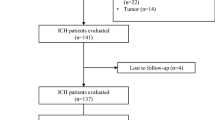Abstract
While intracerebral hemorrhage (ICH) scoring systems provide mortality and morbidity prediction, the actual mortality rates seem to be lower than those predicted by scoring systems in our clinical impression. To assess the validity of the ICH score and the Surgical Swedish ICH (SwICH) score, we retrospectively reviewed surgically treated ICH patients between 2012 and 2019. Uni- and multivariate analyses were performed to identify variables in predicting 30-day mortality. We identified 203 patients (mean ICH score 2.7; mean SwICH score 2.0). The actual 30-day mortality was 7%, which was significantly lower than those predicted by the ICH and the SwICH scores (55% and 16%, respectively; p < 0.001). Both scores were strongly correlated with the modified Rankin scale (mRS) at discharge (correlation coefficient 0.97 and 0.98; critical value 0.81). The only significant prognostic factors for the 30-day mortality by multivariate analysis were anisocoria (p = 0.03) and preoperative Glasgow Coma Scale (p = 0.03). These two factors also predicted mRS at discharge (p < 0.001). After discharge, 15% of patients improved regarding mRS and 29% of wheelchair-bound patients gained the ability to ambulate. No significant relationship existed between the degree of recovery after discharge and preoperative ICH score (p = 0.25). The ICH and SwICH scores were more valid in predicting morbidity, rather than mortality after surgical intervention for ICH. Anisocoria and Glasgow Coma Scale < 7 were the only two factors that predicted 30-day mortality and morbidity at discharge.


Similar content being viewed by others
Data availability
Data transparency was confirmed.
References
Greenberg MS (2016) Handbook of neurosurgery, 9th edn. Thieme, Germany
Fahlström A, Nittby Redebrandt H, Zeberg H, Bartek J Jr, Bartley A, Tobieson L, Erkki M, Hessington A, Troberg E, Mirza S, Tsitsopoulos PP, Marklund N (2019) A grading scale for surgically treated patients with spontaneous supratentorial intracerebral hemorrhage: the Surgical Swedish ICH Score. J Neurosurg:1–8. https://doi.org/10.3171/2019.5.JNS19622
Hemphill JC 3rd, Bonovich DC, Besmertis L, Manley GT, Johnston SC (2001) The ICH score: a simple, reliable grading scale for intracerebral hemorrhage. Stroke 32:891–897. https://doi.org/10.1161/01.str.32.4.891
Hemphill JC 3rd, Farrant M, Neill TA Jr (2009) Prospective validation of the ICH score for 12-month functional outcome. Neurology 73:1088–1094. https://doi.org/10.1212/WNL.0b013e3181b8b332
Appelboom G, Hwang BY, Bruce SS, Piazza MA, Kellner CP, Meyers PM, Connolly ES (2012) Predicting outcome after arteriovenous malformation-associated intracerebral hemorrhage with the original ICH score. World Neurosurg 78:646–650. https://doi.org/10.1016/j.wneu.2011.12.001
Cheung RT, Zou LY (2003) Use of the original, modified, or new intracerebral hemorrhage score to predict mortality and morbidity after intracerebral hemorrhage. Stroke 34:1717–1722. https://doi.org/10.1161/01.Str.0000078657.22835.B9
Rost NS, Smith EE, Chang Y, Snider RW, Chanderraj R, Schwab K, FitzMaurice E, Wendell L, Goldstein JN, Greenberg SM, Rosand J (2008) Prediction of functional outcome in patients with primary intracerebral hemorrhage: the FUNC score. Stroke 39:2304–2309. https://doi.org/10.1161/strokeaha.107.512202
Schmidt FA, Liotta EM, Prabhakaran S, Naidech AM, Maas MB (2018) Assessment and comparison of the max-ICH score and ICH score by external validation. Neurology 91:e939–e946. https://doi.org/10.1212/wnl.0000000000006117
Clarke JL, Johnston SC, Farrant M, Bernstein R, Tong D, Hemphill JC 3rd (2004) External validation of the ICH score. Neurocrit Care 1:53–60. https://doi.org/10.1385/ncc:1:1:53
Aysenne AM, Albright KC, Mathias T, Chang TR, Boehme AK, Beasley TM, Martin-Schild S (2013) 24-hour ICH score is a better predictor of outcome than admission ICH score. ISRN stroke 2013:605286. https://doi.org/10.1155/2013/605286
Ojha P, Sardana V, Maheshwari D, Bhushan B, Kamble S (2019) Clinical profile of patients with acute Intracerebral hemorrhage and ICH score as an outcome predictor on discharge, 30 days and 60 days follow-up. J Assoc Physicians India 67:14–18
Feigin VL, Lawes CM, Bennett DA, Anderson CS (2003) Stroke epidemiology: a review of population-based studies of incidence, prevalence, and case-fatality in the late 20th century. Lancet Neurol 2:43–53. https://doi.org/10.1016/s1474-4422(03)00266-7
Houben R, Schreuder F, Bekelaar KJ, Claessens D, van Oostenbrugge RJ, Staals J (2018) Predicting prognosis of Intracerebral hemorrhage (ICH): performance of ICH score is not improved by adding oral anticoagulant use. Front Neurol 9:100. https://doi.org/10.3389/fneur.2018.00100
Zis P, Leivadeas P, Michas D, Kravaritis D, Angelidakis P, Tavernarakis A (2014) Predicting 30-day case fatality of primary inoperable intracerebral hemorrhage based on findings at the emergency department. J Stroke Cerebrovasc Dis 23:1928–1933. https://doi.org/10.1016/j.jstrokecerebrovasdis.2014.02.006
Author information
Authors and Affiliations
Contributions
All authors read and approved the final manuscript. SH made a study design, collected patient data, drafted and revised the manuscript. KM was a supervisor and made a substantial contribution to revising the original draft. AN, TH, MN, and YS were the supervisors.
Corresponding author
Ethics declarations
Conflict of interest
The authors declare that they have no conflict of interest.
Code availability
Not applicable.
Ethical approval
This study was done under our institutional review board approval and did not require patient consent.
Consent to participate
Our institutional review board did not require informed consent for study participation because this study relied on information obtained as part of routine clinical practice.
Consent for publication
Not applicable.
Additional information
Publisher’s note
Springer Nature remains neutral with regard to jurisdictional claims in published maps and institutional affiliations.
Rights and permissions
About this article
Cite this article
Hong, S., Maruyama, K., Noguchi, A. et al. Is using intracerebral hemorrhage scoring systems valid for mortality prediction in surgically treated patients?. Neurosurg Rev 44, 2747–2753 (2021). https://doi.org/10.1007/s10143-020-01451-8
Received:
Revised:
Accepted:
Published:
Issue Date:
DOI: https://doi.org/10.1007/s10143-020-01451-8




